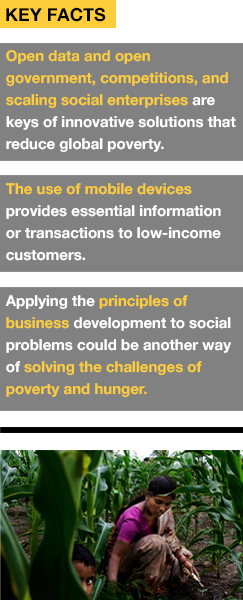
 |
|
 |
 |
 |
 |
 |
 |
 |
| What We Focus On | |||||
| Innovative Solutions |  |
|||
| The civil society, commercial enterprises, social enterprises, and non-profit organizations together need to build and support new business models to deliver public goods and services to the poor. According to statistics from Sustainable Agriculture and Rural Development (SARD), up to 60 % of agricultural workers live in poverty, and less than 20 % have access to basic social security, in many countries. Research and development on crops that are more resilient to severe environments, and sharing of advanced agricultural knowledge and technology, allow effective farming, and save the lives of many poor people in the developing world. For example, although Ethiopia has droughts and unfavorable environment for plants, innovations in farming technology have significantly improved agricultural productivity. Leveraging technology allows insights and ideas abroad to be brought together and create a powerful dialogue about solutions to global poverty. A dispenser system that improves water supply, which was developed by Innovations for Poverty Action (IPA), has helped solving water shortages and improved sanitation in Kenya. It mainly uses dilute chlorine, and is provided at the common water source spot, which can be utilized by people when they collect water. This system was made possible by water-clarifying technology that was distributed regions where take-up of water treatment products is low and waterborne illnesses are widespread. On the other hand, the application of information communication technology plays a significant role in promoting economic growth and combating poverty. Mobile-enabled business models have become leverage to low-income ownership. With rapid growth of private sector investment in mobile communications, large numbers of poor rural communities now have mobile phones, and are easily able to make business transactions. Innovations for the poor can also be found finance and banking sectors. Microfinance brings essential financial services to the impoverished population around the world. Small-size insurance products, designed to meet the needs and cash flows of those who are excluded from formal insurance networks, are offered along the lines of microcredit. Small deposit accounts are also offered to individuals with low income, with low or no minimum balance requirements. |
 |
|||
|
GP3 Korea 2013. Creative Commons Attribution-Non Commercial-ShareAlike 2.0 License The Global Poverty Public Awareness Project in Korea. Designed by Jeong-ae Lee, Ranhee Kim, Suk-hwan Lim, Jaewoo Choi, Ji-won Oh & Seung-won Baek |